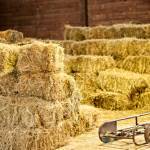Good Management Minimizes Horse Exposure to Mold Spores

Horses that are exposed to dust and mold spores often develop inflammation in their respiratory tracts. This inflammation can lead to infection and less efficient lung function. Owners can change management practices to limit exposure and guard airway health.
The successful environmental control of equine airway disease involves maintaining the horse’s level of exposure to irritants. The best approach lies in minimizing the horse’s exposure to such contaminants at all times. The simplest management method is to turn the horse out for as many hours in the day as possible. This can be facilitated by having a run-in shed in the pasture. When horses cannot be turned out in this way, managing the indoor air quality becomes critical.
Hay is the single most common source of mold spores for the horse. All hay will have some mold spores present. There are many types of mold living on the hay as it grows in the field. These spores come from what are typically referred to as “field fungi” and are usually large and do not have a good chance of getting into the lower airways. The spores that are more dangerous are smaller and more easily inhaled, traveling deep into the horse’s lungs. The highest exposures to mold are associated with hay that has been baled damp, as can happen after a rainy summer. The high moisture content influences the microflora in the bales and metabolic activity of the organisms causes the bales to heat. The molds that thrive in this high moisture and heat are very prolific.
The soaking of hay is a time-proven method of minimizing the horse’s exposure to mold spores. However, feeding soaked poor-quality hay to horses cannot be condoned. As hay that falls to the floor dries, the spores can again become airborne to be inhaled by the horse. Furthermore, even though the spores are not inhaled from soaked hay, they are still ingested along with any toxins present. Molds produce secondary metabolites called mycotoxins, which if present in large enough amounts can cause health problems. Mycotoxins may contribute to reproductive, immunological, respiratory, gastrointestinal and other disorders in livestock, including horses. Some studies have shown the presence of potentially significant levels of mycotoxins in hay being fed to horses. This was in hay that owners were happy with, based on visual inspection.
Alternatives to hay such as alfalfa cubes or haylage can be fed whenever the hay quality is in question. Haylage is mature grass or legume that is baled with a high moisture content but sealed in airtight plastic bags. As fermentation occurs, the pH becomes lower. These acidic conditions inhibit mold growth as long as the bags are airtight. When the bags are opened, the haylage should be fed within two to three days as this product molds very quickly once it has been exposed to air. Broken or damaged bags should not be used. Treated chaffed hay and straw and complete cubed diets also offer alternatives to feeding hay. These products are convenient and usually effective in minimizing respiratory disease.








